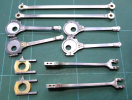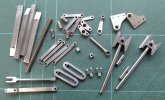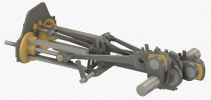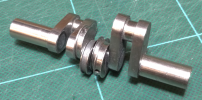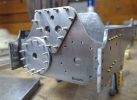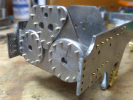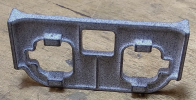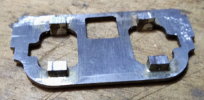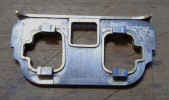NickB
Western Thunderer
This is my second G3 loco. I chose it partly because there is plenty of information available. I got copies of the LNWR drawings from the NRM and visited the preserved Hardwicke at Shildon to take lots of photos (great cooperation from the staff at both places). From that I was able to do a very detailed solid model.
I intend to use commercial laser cutting and 3D printing services, and possibly some CNC machining, partly to speed up the project but also because I'm interested to explore how we can use modern manufacturing methods.
Laser cut steel for the frames and other flat components.
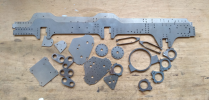
The frames and stretchers were designed with slots and tabs for assembly. The slots were so well cut that I could just put it together for the photo. It will, of course, be soldered up later.
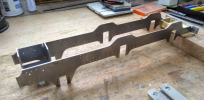
I had the driving wheel centres 3D printed in PA-12 nylon some time ago to see if the combination of printed centre and turned steel tyre was viable.
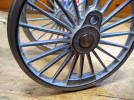
Other components 3D printed.
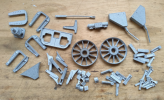
There is also a growing collection of machined parts. These were the ones I judged not feasible or too expensive to have made.
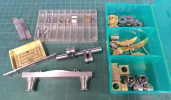
And this is my bevel gear drivetrain. It comprises a Polulu 60W motor which comes with an integrated gearbox to drop the rotational speed to 500 RPM, then a bevel gear to the driving axle. It is a nice compact package that fits between the driving axles. The problem with bevel gears (as I discovered) is the axial force they exert - they try to push each other out of mesh. Not only was it hard to stop the driving gear sliding along the motor shaft, but I was concerned about durability because, when I dismantled the inline gearbox, I discovered that the thrust bearing was quite crude (but at least it had one).
To allow for this I added a ball thrust bearing between the bevel gear and the motor casing to take the load. There wasn't enough room on the driving axle for anything similar to that, so I added a brass sleeve to fit between the spur gear and the gearbox frame. At least that will be quite accessible for regular oiling.
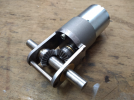
Nick
I intend to use commercial laser cutting and 3D printing services, and possibly some CNC machining, partly to speed up the project but also because I'm interested to explore how we can use modern manufacturing methods.
Laser cut steel for the frames and other flat components.

The frames and stretchers were designed with slots and tabs for assembly. The slots were so well cut that I could just put it together for the photo. It will, of course, be soldered up later.

I had the driving wheel centres 3D printed in PA-12 nylon some time ago to see if the combination of printed centre and turned steel tyre was viable.

Other components 3D printed.

There is also a growing collection of machined parts. These were the ones I judged not feasible or too expensive to have made.

And this is my bevel gear drivetrain. It comprises a Polulu 60W motor which comes with an integrated gearbox to drop the rotational speed to 500 RPM, then a bevel gear to the driving axle. It is a nice compact package that fits between the driving axles. The problem with bevel gears (as I discovered) is the axial force they exert - they try to push each other out of mesh. Not only was it hard to stop the driving gear sliding along the motor shaft, but I was concerned about durability because, when I dismantled the inline gearbox, I discovered that the thrust bearing was quite crude (but at least it had one).
To allow for this I added a ball thrust bearing between the bevel gear and the motor casing to take the load. There wasn't enough room on the driving axle for anything similar to that, so I added a brass sleeve to fit between the spur gear and the gearbox frame. At least that will be quite accessible for regular oiling.

Nick

